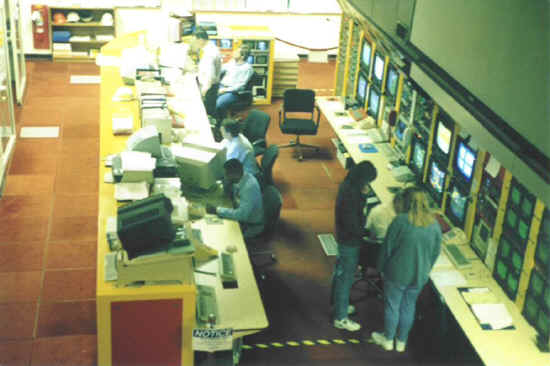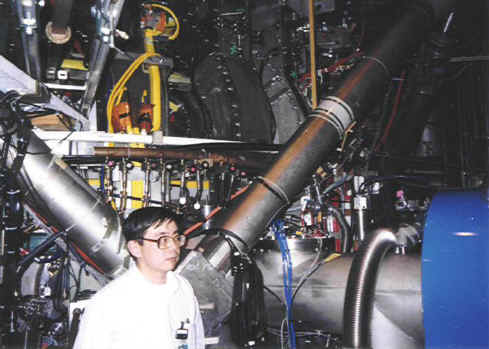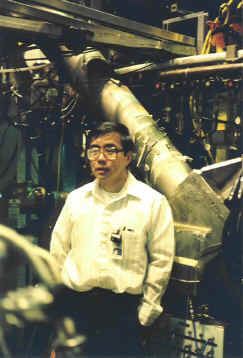
A fusion reactor control room at the Princeton Plasma Physics Laboratory

A fusion reactor control room at the Princeton Plasma Physics Laboratory
The Plasma Physics Laboratory (PPL) at Princeton University is funded by
the U.S. Dept. of Energy and is leading research on this approach. No
material container can withstand fusion temperatures. Instead, PPL's
Tokamak reactors are hollow, doughnut-shaped toruses circled by
electromagnets. The resulting magnetic fields confine the plasma, keeping
it away from the reactor walls. And what if the magnets were to fail? Would
the unconfined plasma become a hydrogen bomb? Just the opposite would
happen. Magnetic confinement is necessary to keep the plasma from colliding
with the walls and cooling off, causing fusion to cease. Hydrogen ions fuse
into helium nuclei, or alpha particles, and give off a neutron. The alpha
particles further heat the plasma, and escaping neutrons will be used to
heat water to power steam turbines. The long-lasting radiation found in
fission reactors is not produced.
The plasma, with its fast-moving electrons and ions, is a conductor that
heats itself through electric resistance (Ohmic) heating. Because
the plasma is a gas, it can also be heated by compressing it. Other heating
methods involve injection of high-energy uncharged (neutral beam) atoms
into the plasma, or with radio waves, like a microwave oven.
Princeton's Tokamak Fusion Test Reactor (TFTR), one of the three largest in
the world, produced its first plasma Christmas Eve, 1982, and has recently
set the world record in momentarily producing 10.7 million watts of power,
enough electricity for 3,000 homes. With this long-sought achievement,
power coming out approaches the amount put in to sustain fusion; this
milestone of energy breakeven is now within reach. A smaller,
new-generation reactor, the Princeton Beta Experiment-Modification (PBX-M),
is a refined design, with more control of plasma current and
cross-sectional shape, needed for operation in a new mode of stability
required by high-pressure plasmas.
Considering the importance of plasma current density, temperature, or
pressure, how do researchers measure these quantities in a 100 million
degree plasma? Thermometers and pressure gauges are definitely out! What
helps make such research challenging is that scientists must also devise
new diagnostic tools to make these measurements.

Dr. Robert Kaita and his PBM-X fusion reactor.
One physicist who is working on a special probe for measuring the plasma
current-density profile in the PBX-M is Robert Kaita, who has been
at the PPL for 18 years and is the head of the diagnostic effort on the
PBX-M. Bob's device injects an electrically-neutral beam of atoms into the
plasma. As they move through the plasma, they are excited by collisions
they experience. Their electrons jump to a higher energy state and release
the extra energy as light, polarized in the direction of the magnetic
field. The local field strength is related to the field generated by the
plasma current, and varies with the density of the current. By sensing the
polarization of the light, the plasma current distribution can be
determined at specific locations across the plasma.
Bob's perspective on his scientific work is wider than the details of
fusion. He has given talks on science, noting its historic foundations laid
by the earliest scientists. They shared a view that the "book of
nature" reveals the same Creator as spoken of in the Bible, and that,
like the laws given in it, the universe must also reflect its rational
order. Science, for them, became the search for these laws.
What are these laws? To use physicist Richard Feynman's example, scientific
research is like learning chess by watching it being played. The rules of
science, like those of chess, are assumed to be comprehensible, so that it
is possible for us to discover them. The physical constants of our universe
- the starting position of the game - are also "just right" so
that life could exist. Tiny changes in the nuclear (strong) or
electromagnetic force constants would have resulted in a universe without
the chemical elements needed for life. Minuscule variations in the density
of the universe just after the Big Bang would have led to a universe that
would have expanded only briefly and then collapsed, so that stars and
planets would not have formed.
Games like chess make sense to us because they are obviously designed, with
starting positions, consistent rules, and a goal. The universe also seems
game-like in significant ways. This analogy suggests that it too has a
designer, and it makes scientific research - the search for the rules
established by that designer - a rational activity.
A well-established method of science is to test promising assumptions, or hypotheses.
A hypothesis for science itself is that the Creator gave us laws of nature
that we can discover. Three centuries of scientific progress support this
assumption; the laws do exist and few scientists today deny their
"incredible elegance, simplicity, and beauty" (Paul Davies, Superforce).
But what to make of this result varies. One possible response is the
Anthropic Cosmological Principle, as Stephen Hawking writes about in his
book, A Brief History of Time: "We see the universe the way it
is because we exist ..." For Hawking, the universe just happened to
turn out such that we are here. Alternatively, as Bob points out, we are
here because of the Creator and the narrow range of possibilities for our
being here are not coincidental. This second response is consistent with
the views held by the originators of science.
Bob concludes by pointing out that regardless of which of these
alternatives we choose, our goal for science is to put it to good use, but
not worship it, for science itself has more basic foundations.
In a recent interview, Bob reflected on the rapidly changing state of
physics in relation to views common in some other scientific fields.
"It's the physicists and astronomers who are constantly in these
crises, trying to figure out why the oldest stars look older than the
universe and what-not. So you could make some rather simple conclusions
that physicists are in a much worse state in their discipline than other
scientists because their theoretical basis is [in crisis]." But, Bob
followed, "To be in crisis is not a bad thing. I think its great
that we have problems that are really tough to solve. This is what makes
the field fun as opposed to: 'Ho hum. Yet another finding that
fits neatly into a sequence.' That just doesn't seem to have the [same]
kind of excitement."

Kaita: "Tough problems make the field fun."
Dr. Kaita concluded the comparison by applying this perspective to the
on-going debate in biology over origins and development of life: "If
there are legitimate questions, why then do many people do the attacks
[against alternative proposals to Darwinism] on metaphysical levels without
addressing the data, whereas we should simply say, `Hey, we have to explain
x and y and z, and we admit this is a problem if the
prevailing theories are inadequate.'"

Dr. Robert Kaita is a member of the American Scientific Affiliation, a fellowship of
about 2,500 Christians in science. If you are interested in more
information about the relationship of science to wider issues, please write
or call the ASA office at:
American Scientific Affiliation
P.O. Box 668
Ipswich, MA 01938-0668
voice: (508) 356-5656
fax: (508) 356-4375
e-mail: asa@asa3.org
This American Scientific Affiliation Science Brief was published in the ASA Newsletter, Vol. 37, No. 5, Sep/Oct 1995.